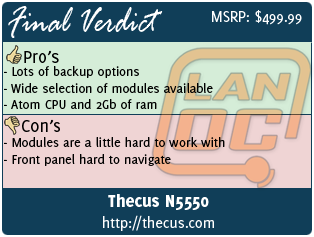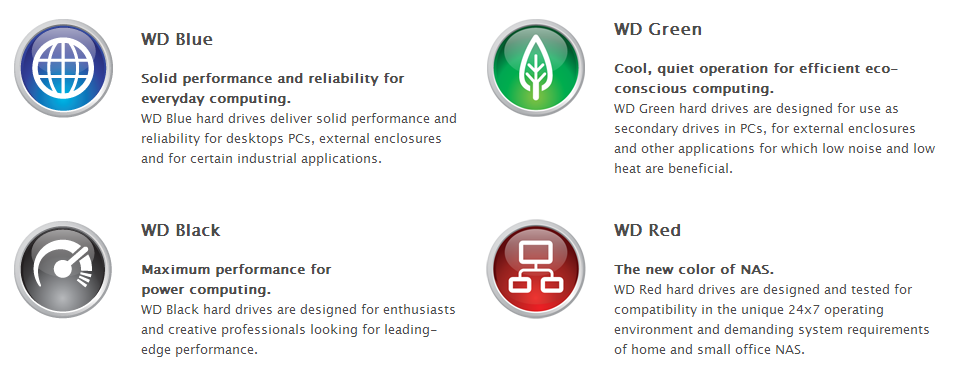 When it comes to storage, there is no question that cloud storage is growing in importance every year. For some this is all that you might need, but if you are like me, you need a lot more than what is available on the cloud. When combined with laptops and multi computer households, adding more storage to just your PC isn’t always the best option. This is where Network Attached Storage comes in: you can have almost endless amounts of storage available in your home. Companies like Thecus have built on that with a collection of features like built in antivirus, Bit-Torrent support, and multimedia support. We are going to take a look at Thecus’s N5550, a 5-bay NAS with USB 3.0.
When it comes to storage, there is no question that cloud storage is growing in importance every year. For some this is all that you might need, but if you are like me, you need a lot more than what is available on the cloud. When combined with laptops and multi computer households, adding more storage to just your PC isn’t always the best option. This is where Network Attached Storage comes in: you can have almost endless amounts of storage available in your home. Companies like Thecus have built on that with a collection of features like built in antivirus, Bit-Torrent support, and multimedia support. We are going to take a look at Thecus’s N5550, a 5-bay NAS with USB 3.0.
Product Name: Thecus N5550 NAS with Western Digital Red Drives
Review Sample Provided by: Thecus
Written by: Wes
Pictures: Wes
Specifications
Thecus N5550 Hardware Specifications
|
Item |
Spec |
|
Processor |
Intel® Atom™ Processor |
|
System Memory |
2GB DDR3 |
|
LAN Interface |
RJ-45x2: 10/100/1000 BASE-TX Auto MDI/MDI-X |
|
USB Interface |
USB 2.0 host port x4 (back x4) |
|
LCM Module |
LCM display |
|
SATA DOM |
1GB |
|
HDMI Output |
HDMI port (back x1) |
|
VGA Output |
VGA port (back x1) |
|
Audio |
MIC input, Line input, Audio output |
|
Disk Interface |
5 x SATA for internal |
|
Power Supply |
200W Power Supply |
|
USB UPS |
Supported |
|
Thermal/Fan control |
Thermal sensor on processor temperature |
|
System Clock |
Battery-backed up system clock |
|
Power Management |
Auto power on after shutdown due to power loss |
|
Buzzer |
Adjustable frequency alarm |
|
Buttons |
Power button |
|
Environment |
Temperature: 5°C to 40°C |
|
Chassis |
Tower Metal Chassis |
|
Dimensions (HxWxD) |
230 x 190 x 240 (mm) |
|
Certificates |
CE/FCC/C-Tick/VCCI/BSMI |
N5550 Software Functions
|
RAID |
|
|
RAID Modes |
RAID 0, 1, 5, 6, 10 and JBOD |
|
Auto-rebuild |
Supported |
|
Hot-swap |
Supported |
|
Hot Spare |
Supported |
|
Online RAID Migration |
Supported |
|
Online RAID Expansion |
Supported |
|
RAID Volume Encryption |
AES256bit |
|
Disk |
|
|
Power Management |
Available spin-down on idle setting |
|
Bad Block Scanning |
Supported |
|
SMART Info |
Supported |
|
SMART Test |
Supported |
|
Disk Roaming |
Supports volume-based roaming to other Thecus NAS |
|
Network |
|
|
Configuration |
Fixed IP address, dynamic IP address |
|
Transport Protocols |
TCP/IP/AppleTalk |
|
File Protocols |
SMB/CIFS, HTTP/HTTPS, FTP, NFS v4, AFP |
|
Link Aggregation |
Load balance, Failover, 802.3ad, Balance-XOR, Balance-TLB, Balance-ALB |
|
TCP/IP |
IPV6 & IPV4 |
|
DDNS |
Supported |
|
SSH |
Supported |
|
UPnP |
Supported |
|
UPnP Port forwarding |
Supported |
|
System status |
|
|
System Monitor |
Monitoring CPU, memory, temperature, fan, network utilization and protocols access user count |
|
Syslog Management |
Send syslog to assigned location |
|
Data Access |
|
|
Client OS Support |
Windows 8/7/Vista/2003/XP/2000 |
|
FTP |
Built-in FTP server with bandwidth control |
|
Secure FTP |
Built-in secure FTP server with bandwidth control |
|
TFTP |
Users can download and upload files with TFTP programs |
|
Download Manager |
BT download (via Transmission module) |
|
Printer Server (IPP) |
Supports USB printers |
|
Data Backup |
|
|
Client Incremental Data Backup |
Acronis True Image (OEM version) |
|
Client System Disaster Recovery |
Acronis True Image (OEM version) |
|
Client Side Backup Software |
Thecus Backup Utility (Windows/Mac OS X) |
|
Data Burn |
Create files to ISO image and burn to optical disc |
|
Mac OS X Time Machine |
Supported |
|
Data Guard |
Remote Backup/Local Backup |
|
Block Level Access |
|
|
iSCSI Target/Initiator |
Supports Microsoft/Mac OS X/Linux initiators and Thecus NAS targets |
|
iSCSI Thin Provisioning |
Supported |
|
MPIO |
Supported |
|
MCS |
Supported |
|
Clustering |
Supported |
|
SCSI3 Persistent Group Reservation |
Supported |
|
Power Management |
|
|
Scheduled Power On/Off |
Supported |
|
Volume Management |
|
|
Multiple RAID |
Supported |
|
Multiple File System Selectable |
EXT3/EXT4/XFS |
|
Multimedia Support |
|
|
iTunes Server |
Supports AAC, MP3 w/ID3 tag and WAV |
|
Piczza!™ Photo Server (via module) |
Supports GIF, JPG (JPEG), BMP and PNG |
|
Media Server |
Supports uPnP AV streaming protocol (via Twonkymedia module) |
|
User Authentication |
|
|
Local User |
Supports built-in user accounts |
|
Local Group |
Supports built-in user groups |
|
Windows ADS |
Supported |
|
LDAP |
Supported |
|
Access Guard |
Supports Black & White list/IP Filter |
|
Cloud Backup |
|
|
DropBox |
Supported (via module) |
|
ElephantDriver |
Supported (via module) |
|
Amazon S3 |
Supported |
|
File System |
|
|
Type |
Journaling File System |
|
Language Support |
Unicode Support |
|
Authorization (ACL) |
“Read”, “write”, or “deny” privileges to individual users or groups in folders and sub-folders |
|
User Quota |
Supported |
|
Administration |
|
|
User Interface |
Web-based user interface supports English, Traditional Chinese, Simplified Chinese, Japanese, Korean, French, German, Italian, Spanish, Russian, Polish, Portuguese, Turkish and Czech. |
|
Utility Program |
MS Windows Setup Wizard |
|
Email Notifications |
Sends system messages via email to the system administrator |
|
SNMP Trap |
System information trap out |
|
Mobile Applications (iOS/Android) |
|
|
Thecus Dashboard |
Mobile monitoring and administration (via module) |
|
T-OnTheGo™ (iOS) |
Upload, download and stream multimedia |
|
Data Security |
|
|
Virus Scan |
Supports McAfee® (via module) |
|
Capacity Expansion |
|
|
Stackable |
Can extend for 5 additional iSCSI volumes from other Thecus NAS |
|
Others |
|
|
Recycle Bin |
Supported |
|
Web Disk |
Supported (via module) |
|
Web Server |
Supported (via module) |
|
ISO Mount |
Supported |
|
IP Cam Surveillance |
Supports up to 5 IP cameras (via module) |
|
Auto Module Installation |
Thecus’ module server automatically provides the latest modules and updates through the user interface. |
|
Local Display |
X-Window via HDMI output |
Western Digital Red 1TB Hard Drives
|
Model number |
WD10EFRX |
|
Interface |
SATA 6 Gb/s |
|
Formatted capacity |
1,000,204 MB |
|
User sectors per drive |
1,953,525,168 |
|
Advanced Format (AF) |
Yes |
|
SATA latching connector |
Yes |
|
Form factor |
3.5-inch |
|
RoHS compliant |
Yes |
|
Performance |
|
|
Data transfer rate Buffer to host (max) Host to/from drive (typical) |
6 Gb/s 150 MB/s |
|
Cache (MB) |
64 |
|
Rotational speed (RPM) |
IntelliPower |
|
Reliability/Data Integrity |
|
|
Load/unload cycles |
600,000 |
|
Non-recoverable read errors per bits read |
|
|
MTBF (hours) |
1,000,000 |
|
Limited warranty (years) |
3 |
|
Power Management |
|
|
12VDC (A, peak) |
1.20 |
|
Average power requirements (W) Read/write Idle Standby Sleep |
3.7 3.2 0.6 0.6 |
|
Environmental Specifications |
|
|
Temperature (°C, on the base casting) Operating Non-operating |
0 to 70 -40 to 70 |
|
Shock (Gs) Operating (2 ms, read/write) Operating (2 ms, read) Non-operating (1 ms) |
30 65 350 |
|
Average acoustics (dBA) Idle mode Seek mode |
21 22 |
|
Physical Dimensions |
|
|
Height (in./mm, max) |
1.028/26.1 |
|
Length (in./mm, max) |
5.787/147 |
|
Width (in./mm, ± .01 in.) |
4/101.6 |
|
Weight (lb./kg, ± 10%) |
0.99/0.45 |
Packaging
The Thecus N5550 came in a fairly simple cardboard box. They packed all of their information onto the main stickers on the front and back of the box. That sticker has a photo of the N5550 and a short list of its features. You also see the Atom logo, a 2GB DDR3 logo, along with a few other important logos of the NAS’s key features.



Inside the H5550 was wrapped in a plastic bag and then protected with foam on each side to keep it well protected in its box. Along with the N5550 itself you also get your paperwork, Ethernet cable, screws and keys, and all three software discs.





Western Digital Red Drives
When we were looking for drives to test with the N5550, there was one model specifically that came to mind. Western Digital recently introduced a new series of drives made specifically for NAS called Red series drives. They shipped three of their 1Tb drives out for testing with the N5550, leaving a little room for expansion in the future but still a chance to see how the Red drives perform and hold up in a NAS environment.
So what sets the Red drives apart from everything else that Western Digital sells? First you have to understand their product lineup for consumers. Western Digital has four consumer product lines for internal drives, three of those you have most likely seen before. The Green, Blue, and Black series’ of drives all have different priorities. The Green line for example are low noise, low heat, and low power drives. They aren’t designed to be main drives; performance isn’t the priority in this case. That is exactly the opposite of their Black series drives, designed for top performance only. The Blue series drives fit in the middle between the Black and Green as a middle ground normal drive.
As you can tell, the original three drive series’ are all focused on in PC use. The Red drives are set apart a little because they are designed specifically for NAS use. This means the Red drives have a few features that set it apart from the others. Let’s take a look at those features.
Western Digital took a few key features from their enterprise drives to give the RED drives their NAS support. Part of that is keeping the thermals and vibration down, this is especially important when you are running multiple drives close together. Here is an image that Western Digital has on their website showing the difference in thermals between a competitor and one of their Red drives. As you can see, the bearing isn’t putting out heat. This has a lot to do with reduced vibration, and putting less load on the bearing. They did this by using what they call 3D Active Balance Plus, an enhanced balance control technology.
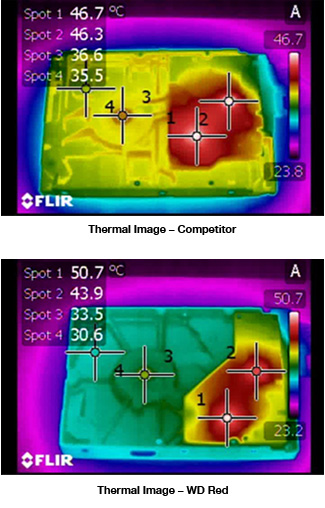
Something else that sets the Red drives apart is their compatibility in NAS environments. Some of you may have run into this in the past, but the Western Digital Green drives were known for having issues in a lot of NAS and server boxes. Red drives are tested for compatibility with a list of different NAS options, you can see the full list HERE. This way you know going into it that you won’t have any issues once everything comes in. There is nothing worse than getting excited about parts coming in, only to have to wait to send them back and have new parts come in.
Another issue that you will run into when dealing with consumer drives in a NAS is problems with a RAID failing seemingly randomly. This is due to the way consumer drives handle error recovery in comparison to business class drives. To put it simply, consumer drives will attempt to correct the issue longer, locking the drive up during that time and sometimes causing the drive to drop out of the RAID. The Red drives handle this situation like enterprise drives and have a lower time allowing the RAID to react quicker and pull the info off of another drive for recovery without disrupting your computing. The Red drives are currently configured for a soft time limit of 7 seconds, but this can actually be adjusted as needed using software like smartctl.
Where things get a little fuzzy in the Red specification listing is when you go to look up the drives actual spindle speed. Typically this is how you would get an idea of the drives performance. Western Digital lists this officially as IntelliPower; this is similar to the Green series of drives that run at 5200 RPM at most. This wouldn’t be a big shock considering that the Red drives are taking a lot of the features of the much more expensive RE4 drives, having the same RPM might cut into the RE4’s market a little too much.






What’s inside the N5550
Normally when you see a NAS you don’t think of it as a small PC. After checking out the exterior of the N5550 we are going to dig in a little and see what makes it all tick.
The exterior of the N5550 is fairly basic. The front of the device features four control buttons, an LCD screen, and a small window that gives a peak at status lights up the front of the device. The front also opens up to give you access to all five hard drive trays.


With the door open you can see that the door has mesh on it to allow for a little airflow through it to keep everything cool. You now have full view of the five drive trays; the door has mesh on it to allow for a little airflow through it to keep everything cool. You can also see that they actually have locks, this is great if you are only running a few drives and you plan on adding more in the future, this way you can lock down the loaded bays to prevent you from pulling one out accidentally. Behind the door we also have the power and reset buttons, this keeps them from being bumped day to day. There is also a USB 3.0 port right on the front of the N5550. This was especially impressive to me, all of the other NAS that we have in the office only have USB 2.0 ports. If you need to pull files off or put files on, or even temporarily expand capacity, you will have the high transfer speeds of USB 3.0.




With two of the hard drive trays pulled out, here is a peek inside, you can see the hot swap PCB.

Both sides of the N5550 have a corner perforated for additional airflow into the device. Beyond that there isn’t anything going on the top or side panels.

On the back you have more ventilation holes as well as two fans. One is a large 120mm fan that is located behind the hard drives. This fan will help keep your drives cool during their 24 hour operation. The second smaller fan is part of the power supply and located next to the power plug and on off switch. The back of the N5550 has a surprising amount of connections for a NAS. You have everything from microphone and headphone ports as well as an audio input. You have four USB 2.0 ports and an e-SATA port for additional storage connections, the USB 3.0 on the front would still be the fastest. You also have both HDMI and VGA ports for hooking up to a projector or television, something you wouldn’t normally see on a NAS as well. Last but certainly most important you have two Ethernet connections down at the bottom. The back of the N5550 looks more like a full PC than a NAS, but its feature set is more than a normal NAS as well.




After taking the outside shell of the N5550 off, I was greeted by a motherboard that takes up the entire height of the device. This is obviously designed specifically for the N5550, this isn’t a Mini ITX board or anything off the shelf. The LED indicator lights on the front of the N5550 are directly on the motherboard for example, this wouldn’t work in just any case. Beyond that you do get a peak as the Atom processor that powers everything as well as the small ssd that the OS runs on. It’s also nice to see that the RAM is actually replaceable if you decide to upgrade in the future as well.




One thing I noticed when taking the cover off was the on one of the sides they have actually covered up the ventilation holes in the case with a clear film. I’m assuming that they did this for a reason, but it’s still not something you see every day.



Software
With the N5550 hooked up and the three Western Digital RED drives installed I finally had a chance to boot everything up and to take a peek at its software. Once I reached the IP of the device, I was greeted with a fairly basic and clean login screen. There is also a flash version of this same page, personally I found the flash version to be a little harder to figure out though. It does look much better, but without clear labels as to what each option does it takes some getting used to.
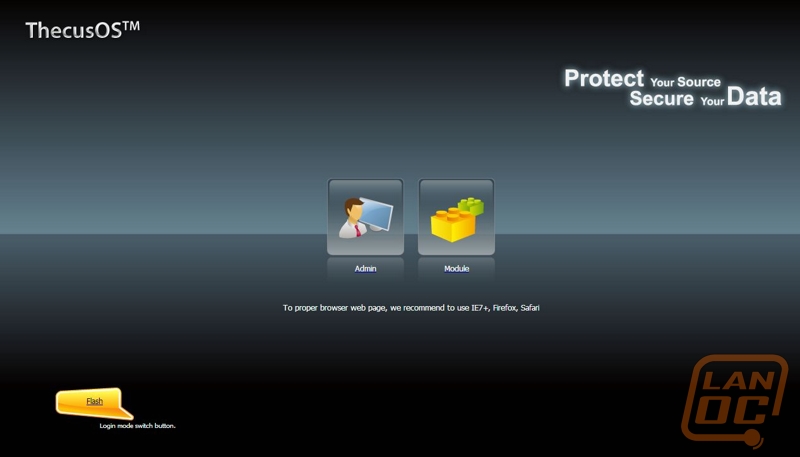
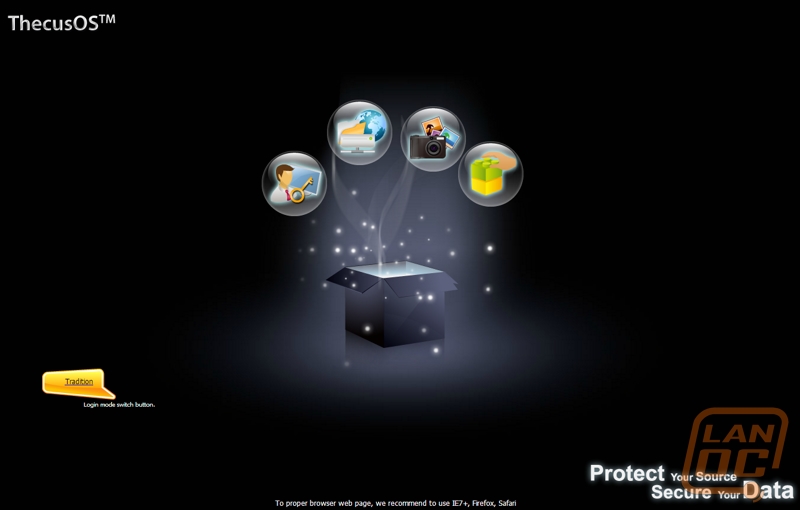
Before doing anything else, it was important to get the hard drives installed and formatted and, in our case, setup the RAID. This way I would be able to play around with every option and later also put the N5550 to the test to see how it performs as well. Thecus does give you an easy way to setup your RAID using a wizard, as you can see below they just ask you simple questions and then it sets everything up for you.
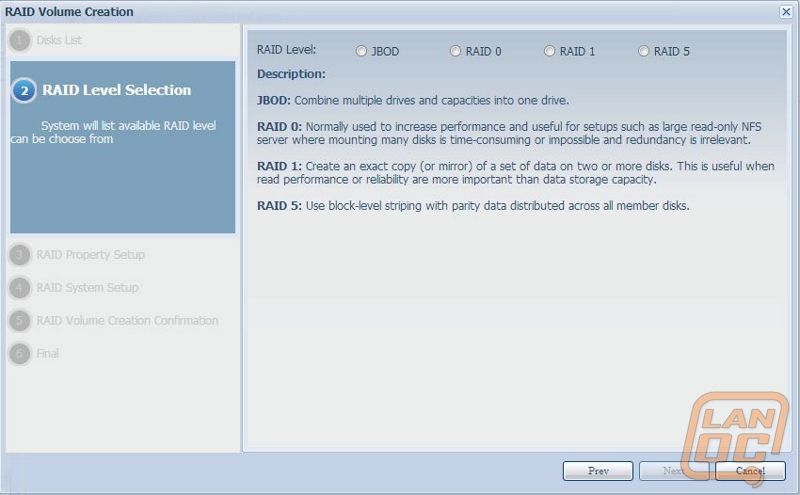
With our RAID setup, we are now free to explore the rest of the N5550’s interface. The first thing that stood out to me was the notifications up in the top right corner of the screen. Much like a facebook notification, Thecus has set it up to let you know if there are any problems. In this case, I put in the wrong password and one of our notifications was letting me know that someone attempted to log in with the wrong password. Its normal for all NAS drives to track this sort of thing, but putting the notifications in an easy to find location like that does help bring attention to them and show their importance.
As for the rest of the layout, the N5550’s interface was similar to what we have seen from its competition. On the left side of the page you have six sections, with each having multiple options to work with. For example, system information has general, status, system log, online registration, syslog management, system monitor, and hardware information. All of those options are important ways for you to get updates on the N5550’s status, performance, and even details on the hardware inside. All of those options are important but maybe not something you would check every day, breaking them up under System Information as a whole keeps the interface from being to cluttered.
Opening each of the six sections closes the other sections, personally I would love to be able to open one or two at a time and minimize the others. This way you can flip to what is important to you quickly.
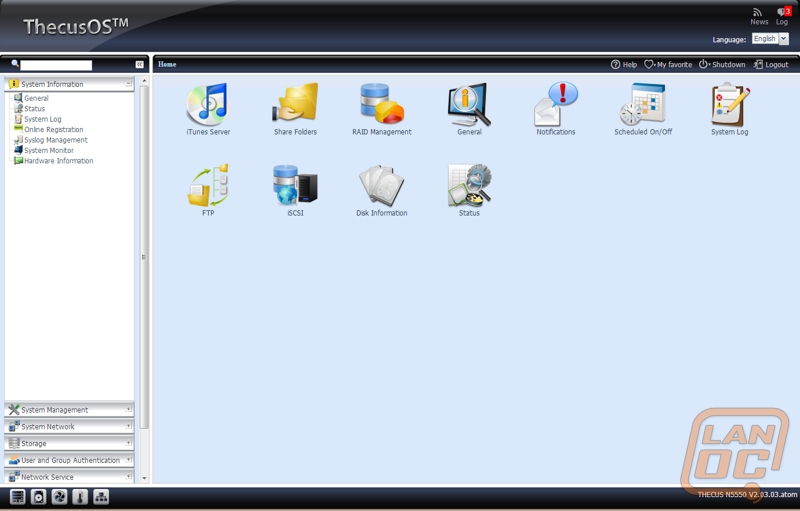
The best option listed in the first section is the system monitor, from here you can monitor both with graphs and normal numbers the N5550’s performance both over the network as well as memory and CPU performance. You even have options to watch fan speed and NAS temperatures to make sure that it isn’t overheating in the location that you store in. This is especially important to me because ours is in a closest with a server and two other NAS’s and two laser printers. It’s easy to forgot about your devices and just assume they are safe because they are still running, this way you can double check to make sure you aren’t causing any damage due to temperature’s.
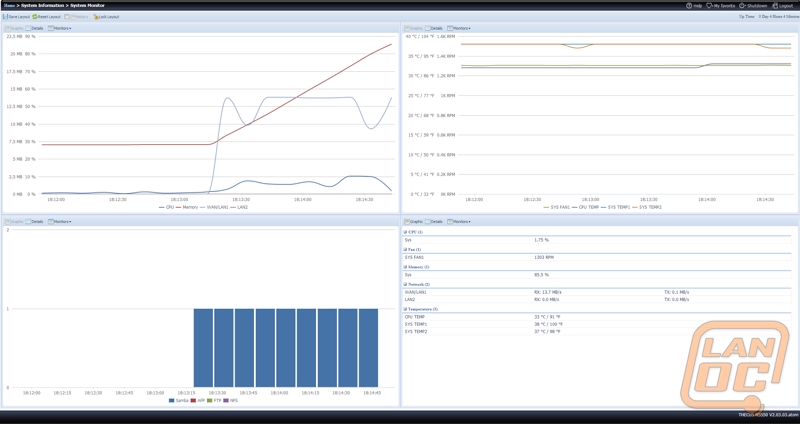
Moving down into the system management section, I came across an option that caught my interest, called scheduled on/off. This option allows you to set times each day for the N5550 to be on and off. This is interesting especially for power usage but also just for the wear and tear on the drives and NAS itself. For a business, they could set the NAS to power on just before opening time and stay off overnight and over weekends when it wouldn’t be getting any use. In my situation where I can be found working day, night and weekend depending on my schedule, it would never work out. But it’s great that they include that as an option.
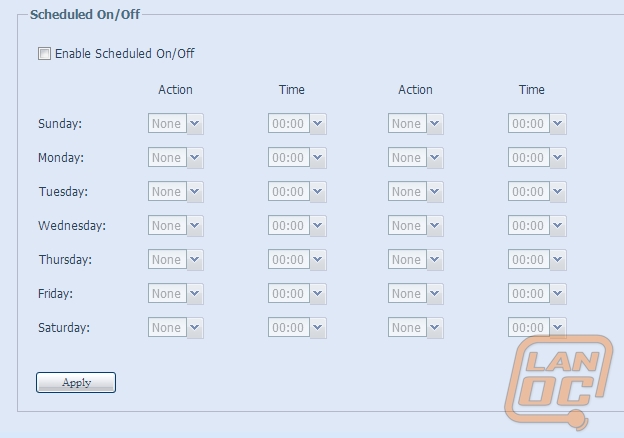
The network option was fairly basic, with the normal options to set your IP on both of the two network ports. They do include support for link aggregation to be able to use the two network ports together as one for more speed but unless you are running SSD’s in the N5550 that will most likely not be an issue, although with 5 hard drives as hard drive speeds increase it is still getting close.
What I did find interesting were the little things. Under storage>disc information I found it very helpful that when you mouse over one of the drives listed that it shows you where in the NAS the drive is located. This may be a small thing, but when you have a drive in a raid, the last thing you want to do is remove the wrong drive and break your RAID entirely.
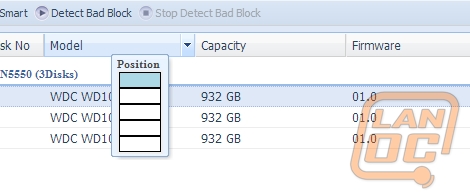
Also under storage, you have the ability to mount ISO’s stored on the NAS. This allows you to burn ISO’s of all of your important software discs and to just run them right off of your NAS, just like in the old days when we would see CD drive arrays. The difference being, this is much smaller and it is also will perform much quicker.
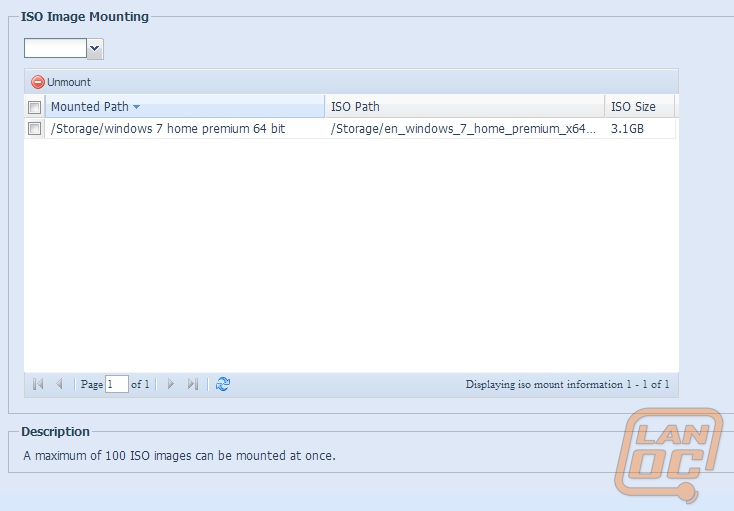
Even when using a NAS and RAID it’s always good to consider ways to backup your backup. Thecus has given a couple different options. First you have their data backup wizard that allows you to setup a backup to a remote Thecus NAS, another NAS on your network, or even Amazon’s S3 service. The cloud option is especially interesting to me. It’s great to see this included right with the N5550. No matter what you go with, they have made it simple to do with the wizard.
If none of those options will work for you, another option you have is the old school way of backing up to dvd’s by using a USB DVD burner. Thecus supports this with its data burn option. This also starts to explain why the N5550 has so many USB ports, Thecus has packed in a lot more functionality than our other NAS’s.
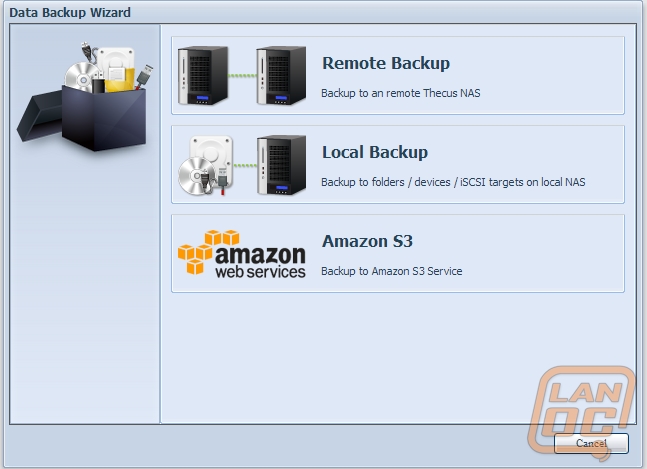

The last but most interesting functionality of the N5550’s software is its ability to add modules. You can find those modules both on their website and through outside forums that use their API. From Thecus you have the following list of modules
Access Guard module
Dashboard Module (for iphone support)
Dropbox module
ElephantDrive module
HiSSH module
IP CAM module
Local Display module
Mail server module
MySQL module
NZB module
Piczza! Module
Raid Replication Module
Rsync backup module
T-OnTheGo and Transcoding service Module
Transmission (BT Client) Module
Twonky media server module
USB & eSATA schedule backup module
VirusScan module (McAfee Antivirus )
Web Server module
WebDisk module
That is a hell of a list just from them alone. A few notable modules are the Dropbox, Local Display, virus scan, transmission, and webserver modules. With just the modules provided by Thecus, you can run a full web server including a database as well as download your torrent files using the NAS itself. The local display option is especially interesting because it puts to use the HDMI output built into the N5550 and allows you to run a mouse and keyboard while being hooked to your tv. This lets you control the N5550 as well as gives you full media playback options, meaning the N5550 could double as your HTPC if needed.
When digging into the 3rd party options for modules you will find anything else you could ever imagine really. I even found people running their Minecraft servers on their NAS! Other interesting options are different multimedia suites like XBMC, VCL, and Plex, Usenet grabbers, even mumble servers. The options are almost limitless really.
When playing around with the module ability of the N5550, I was a little disappointed in how easy it is to set these up. I would understand it from the 3rd party modules, but when installing the dropbox module for example. You have to logout of the control panel and log into the module section to setup your modules. This made the process more complicated than I would have liked. But considering the selection of modules you have to work with, it’s still worth it. Hopefully Thecus will work on making this easier in the future though.
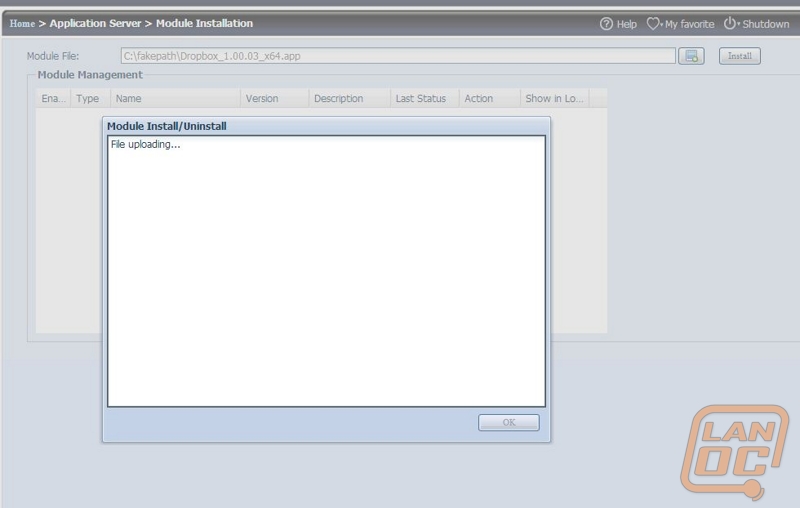
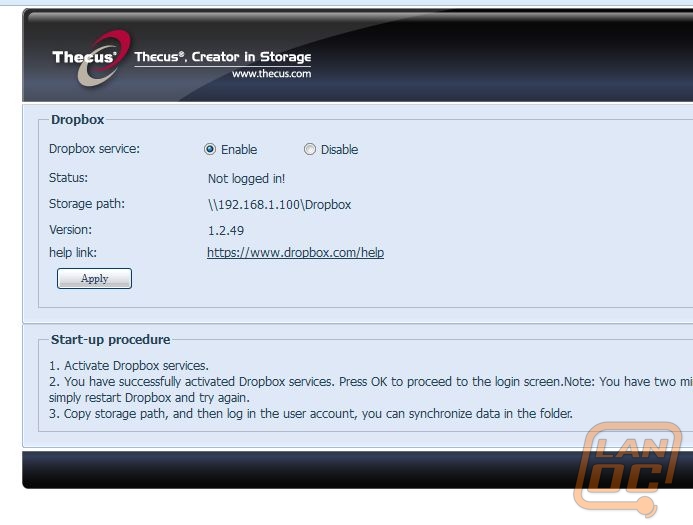
Performance
In order to put the Thecus N5550 to the test we used the Intel NAS Performance toolkit to test the over the network transfer speeds of the N5550 in multiple situations. I ran through the same tests with just a single drive as well as with all three of the Western Digital RED drives running in RAID 0. To get comparison results we tossed in results from a Qnap NAS and Seagate NAS that we had sitting around. The Qnap is running two 3tb Seagate hard drives in RAID 0 and the Seagate has 4 2tb drives in RAID 5. These results won’t compare directly with the Thecus due to using different drives, but it will give you a rough idea.

As you can see right away, both Thecus N5550 results stand out from the rest. The difference between the single disc performance and the three disc RAID 0 isn’t large on the N5550, but you do see a boost in everything but HD Playback and record. On some tests like the Photo Album benchmark the difference was less than a half MB/s. When compared to the Qnap drive, the difference is clear. In everything but the HD Video Playback benchmark the single disc results outperformed the RAID 0 in the Qnap. The Seagate results were out of the running from the start; running a RAID 5 means backing up every file on the fly slowing things down considerably. All in all, it’s clear that the Atom processor and 2 gigs of ram give the N5550 an advantage. As we mentioned before, the Western Digital RED drives are quick, but shouldn’t be able to outperform drives with a higher spindle speed. When you take that into account, the results are even more impressive.
Overall and FV
I’m impressed with what Thecus put together with the N5550. Just the hardware alone is well layed out and packed full of features like multiple USB ports and audio/video connections. This is also the first NAS we have had in that has had a USB 3.0 port. I would have liked to of seen two, but even just the one will make a word of difference when backing up to/from a USB 3.0 device in the future. The dual core Atom Processor ended up being more than enough processing power while still being very energy efficient. And the 2 gigs of RAM were helpful as well, not to mention you can upgrade the ram in the future if you need to. I did find the front control panel on the N5550 a little hard to navigate, I ended up only ever using it to verify that the device was booted up, and to check quickly that no drives have failed.

The N5550’s software was also impressive. Thecus packed in nearly every feature you could ever ask for. The features that weren’t packed in are most likely available as modules as well. The module selection was most impressive between what Thecus had to offer and the third party offerings. You could literally use this NAS for any type of server functionality that you might need. Not to mention the module that allows you to use your N5550 as a basic HTPC when it is hooked to your TV. My only complaint was that the modules could be a little hard to install when you have to log in and out over and over again to access them. With built in integration with Amazon S3, and a wizard or two that allows you to back up to s3, another local NAS, a remote Thecus NAS, or DVD’s. You have a wide selection of ways to make sure that you won’t lose data in the end. On top of that they even include a copy of Acronis True Image, giving you options on how to backup to your N5550 as well.

When you put it all together, you have a nice package from Thecus. It’s not any one feature that makes the N5550 great. It’s the 5 disc capacity, the software, and the hardware to support it all put together. If you are on the market for a NAS that has room for expansion or if you need a whopping 18BTB’s in capacity, the N5550 is up your ally. With a MSRP of $499.99, it’s not a cheap purchase, especially when considering you still need to fill it with hard drives. But even at that price you would be hard pressed to be able to build a server that will have the same functionality, especially considering there module selection. On top of that, you can find it for considerably (over $120) less if you look around a little online. At that price it’s no question at all.
